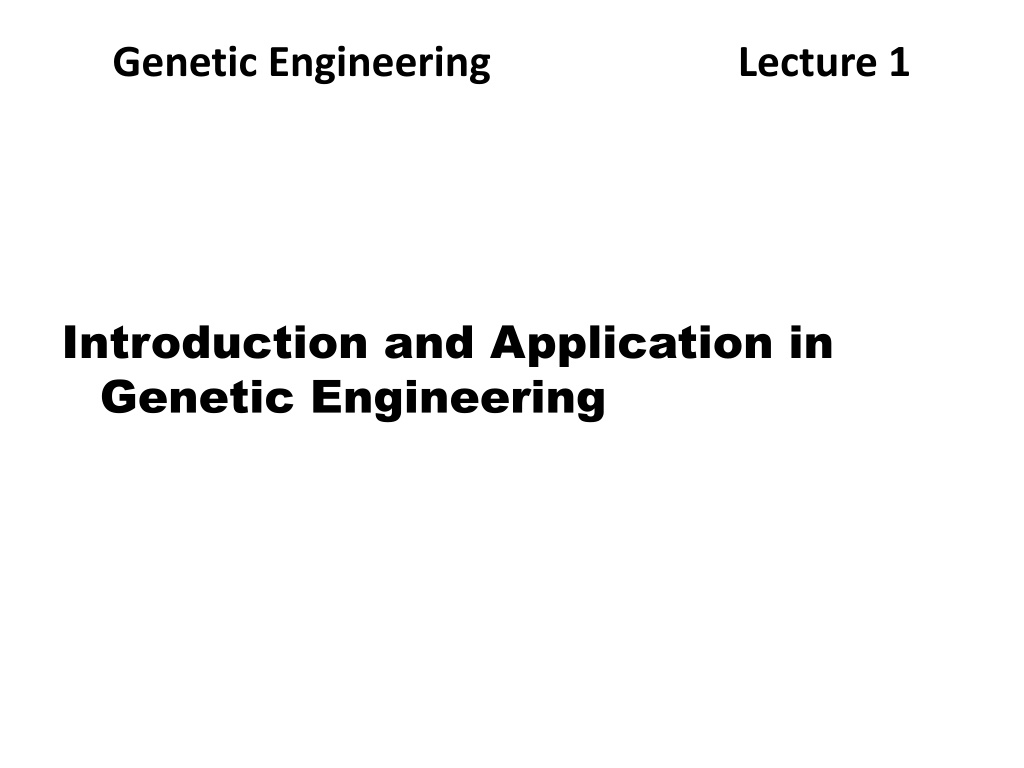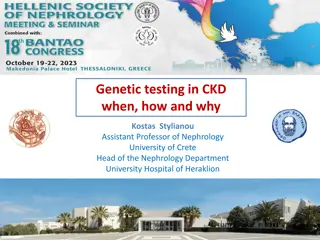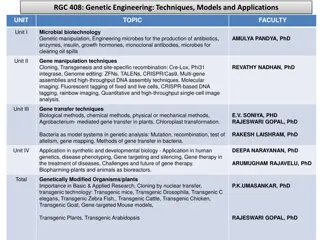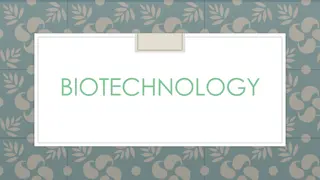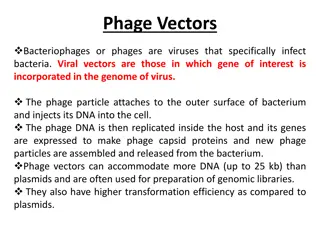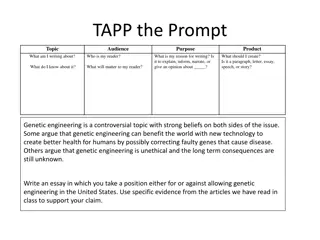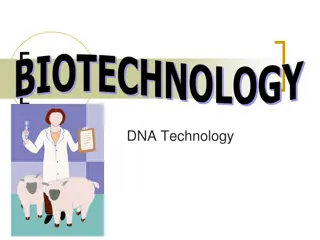Understanding Genetic Engineering: Applications and Advancements
Genetic engineering involves modifying organisms' DNA to improve traits like productivity, disease resistance, and nutrient content. Recombinant DNA technology has revolutionized agriculture by creating genetically modified crops that require less fertilizer, resist pests, and produce their own insecticides.
Download Presentation

Please find below an Image/Link to download the presentation.
The content on the website is provided AS IS for your information and personal use only. It may not be sold, licensed, or shared on other websites without obtaining consent from the author. Download presentation by click this link. If you encounter any issues during the download, it is possible that the publisher has removed the file from their server.
E N D
Presentation Transcript
Genetic Engineering Lecture 1 Introduction and Application in Genetic Engineering
Genetic modification, and recombination of DNA or other nucleic acid molecules in order to modify an organism or population of organisms. The term genetic engineering initially referred to various techniques used for the modification or manipulation of organisms through the processes of heredity and reproduction. As such, the term included both artificial selection and all the biomedical techniques, among them artificial fertilization in vitro fertilization (e.g., test-tube babies), cloning, and gene manipulation. In the latter part of the 20th century, however, the term came to refer more specifically to methods of recombinant DNA technology (or gene cloning ), in which DNA molecules from two or more sources are combined either within cells or in vitro and are then inserted into host organisms in which they are able to propagate . engineering, the artificial manipulation,
The possibility for recombinant DNA technology emerged with the discovery of restriction enzymes in 1968 by Swiss microbiologist Werner Arber. The following year American microbiologist Hamilton O. Smith purified so-called type II restriction enzymes, which were found to be essential to genetic engineering for their ability to cleave a specific site within the DNA (as opposed to type I restriction enzymes, which cleave DNA at random sites). American molecular biologist Daniel Nathans helped advance the technique of DNA recombination in 1970 71 and demonstrated that type II enzymes could be useful in genetic studies. Genetic engineering based on recombination was pioneered in 1973 by American biochemists Stanley N. Cohen and Herbert W. Boyer, who were among the first to cut DNA into fragments, rejoin different fragments, and insert the new genes into E. coli bacteria, which then reproduced.
The term "genetic engineering" was first coined by Jack Williamson in his science fiction novel Dragon's Island, published in 1951.one year before DNA's role in heredity was confirmed by Alfred Hershey and Martha Chase.
What are the Benefits of Genetic Engineering 1.Application inAgriculture: An important application of recombinant DNA technology is to alter the genotype of crop plants to make them more productive, nutritious, rich in proteins, disease resistant, and less fertilizer consuming. Recombinant DNA technology and tissue culture techniques can produce high yielding cereals and vegetable crops. Some plants have been genetically programmed to yield high protein grains that could show resistance to heat, moisture and diseases. Some plants may even develop their own fertilizers some have been genetically transformed to make their own insecticides. Through genetic engineering some varieties have been produced that could directly fix atmospheric nitrogen and thus there is no dependence on fertilizers. Scientists have developed transgenic potato, tobacco, cotton, corn, strawberry, that are resistant to insect pests and certain weedicides. Bacterium, Bacillus thurenginesis produces a protein which is toxic to insects. Using the techniques of genetic engineering, the gene coding for this toxic protein called Bt gene has been isolated from bacterium and engineered into tomato and tobacco plants. Such transgenic plants showed nee to tobacco horn worms and tomato fruit worms. These genotypes are awaiting release in USA.
There are certain genetically evolved weed killers which are not specific to weeds alone but kill useful crops also. Glyphosate is a commonly used weed killer which simply inhibits a particular essential enzyme in weeds and other crop plants. A target gene of glyphosate is present in bacterium Salmonella typhimurium. A mutant of S. typhimurium is resistant to glyphosate. The mutant gene was cloned to E. coli and then recloned to Agrobacterium tumifaciens through its Ti Plasmid. Infection of plants with Ti plasmid containing glyphosate resistant gene has yielded crops such as cotton, tabacco maize, all of which are resistant to glyphosate. This makes possible to spray the crop fields with glyphosate which will kill the weeds only and the genetically modified crops with resistant genes remain unaffected.
The gene transfer technology can also play significant role in improved variety of timber trees. Several species of microorganisms have been produced that can degrade toxic chemicals and could be used for killing harmful pathogens and insect pests. For using genetic engineering techniques for transfer of foreign genes into host plant cells, a number of genes have already been cloned and complete libraries of DNA and mt DNA of pea are now known. producing new and
Some of the cloned genes include: (i) Genes for phaseolin of french bean, (ii) Few phaseolin leg haemoglobin for soybean, (iii) Genes for small sub-unit RUBP carboxylase of pea, and i genes for storage protein in some cereals. Efforts are being made to improve several agricultural crops using various techniques of genetic engineering which include: (i) Transfer of nitrogen fixing genes (nif genes) from leguminous plants into cereals. (ii) Transfer of resistance against pathogens and pests from wild plants to crop plants. (iii) Improvement in quality and quantity of seed proteins. (iv) Transfer of genes for animal proteins to crop plants. (v) Elimination of unwanted genes for susceptibility to different diseases from cytoplasmic male sterile lines in crop like maize, where cytoplasmic male sterility and susceptibility are located in mitochondrial plasmid. (vi) Improvement of photosynthetic efficiency by reassembling nuclear and chloroplast genes and by the possible conversion of C3plants into C4plants. (vii) Development of cell lines which may produce nutritious food in bioreactors.
2. Application to Medicine: Genetic engineering has been gaining importance over the last few years and it will become more important in the current century as genetic diseases become more prevalent and agricultural area is reduced. Genetic engineering plays significant role in the production of medicines. Microorganisms and plant based substances are now being manipulated to produce large amount of useful drugs, vaccines, enzymes and hormones at low costs. Genetic engineering is concerned with the study (inheritance pattern of diseases in man and collection of human genes that could provide a complete map for inheritance of healthy individuals.
Gene therapy by which healthy genes can be inserted directly into a person with malfunctioning genes is perhaps the most revolutionary and most promising aspect of genetic engineering. The use of gene therapy has been approved in more than 400 clinical trials for diseases such as cystic fibres emphysema, muscular dystrophy, adenosine deaminase deficiency. Gene therapy may someday be exploited to cure hereditary human diseases like haemophilia and cystic fibrosis which are caused by missing or defective genes. In one type of gene therapy new functional genes are inserted by genetically engineered viruses into the cells of people who are unable to produce certain hormones or proteins for normal body functions. Introduction of new genes into an organism through recombinant DNA technology essentially alters protein makeup and finally ibody characteristics.
Vaccines: Recombinant DNA Technology is also used in production of vaccines against diseases. A vaccine contains a form of an infectious organism that does not cause severe disease but does cause immune system of body to form protective antibodies against infective organism. Vaccines are prepared by isolating antigen or protein present on the surface of viral particles. When a person is vaccinate against viral disease, antigens produce antibodies that acts against the viral proteins and inactivate them. With recombinant DNA technology, scientists have been able to transfer the genes for some viral sheath proteins to vaccinia virus which was used against small pox. Vaccines produced by gene cloning are contamination free and safe because they contain only coat proteins against which antibodies are made. A few vaccines are being produced by gene cloning, e.g., vaccines against viral hepatitis influenza, herpes simplex virus, virus induced foot and mouth disease in animals.
Hormones: Until recently the hormone insulin was extracted only in limited quantities from pancreas of cows and pigs. The process was not only costly but the hormone sometimes caused allergic reactions in some patients of diabetes. The commercial production of insulin was started in 1982 through biogenetic or recombinant DNA technology and the medical use of hormone insulin was approved by food and drug administration (FDA) of USAin 1982. The human insulin gene has been cloned in large quantities in bacterium E. coli which could be used for synthesis of insulin. Genetically engineered insulin is commercially available as humilin. Lymphokines: Lymphokines are proteins which regulate immune system in human body, -Interferon is one of the examples. Interferon is used to fight viral diseases such as hepatitis, herpes, common colds as well as cancer. Such drugs can be manufactured in bacterial cell in large quantities. Lymphokines can also be helpful for AIDS patients. Genetically engineered interleukin-II, a substance that stimulates multiplication of lymphocytes is also available and is being currently tested onAIDS patients.
Somatostatin: A fourteen aminoacid polypeptide hormone synthesized by hypothalamus was obtained only in a small quantity from a human cadavers. Somatostatin used as a drug for certain growth related abnormalities appears to be species specific and the polypeptide obtained from other mammals has no effect on human, hence its extraction from hypothalamus of cadavers. Genetic engineering technique has helped in chemical synthesis of gene which is joined to the pBR 322 plasmid DNA and cloned into a bacterium. The transformed bacterium is converted into somatostatin synthesising factory. ADA (adenosine deaminase) deficiency is a disease deficiency which killed the bubble boy David in 1984. like combined immune
Erythropoetin, a genetically engineered hormone is used to stimulate the production of red blood cells in people suffering from severe anaemia. Production of Blood clotting factors: Normally heart attack is caused when coronary arteries are blocked by cholesterol or blood clot. plasminogen is a substance found in blood clots. Genetically engineered tissue plasminogen activator (tPA) enzyme dissolves blood clots in people who have suffered heart attacks. The plasminogen activator protein is produced by genetech company which is so potent and specific that it may even arrest a heart attack underway. Cancer: Cancer is a dreaded disease. Antibodies cloned from a single source and targetted for a specific antigen (monoclonal antibodies) have proved very useful in cancer treatment. Monoclonal antibodies have been target with radioactive elements or cytotoxins like Ricin from castor seed to make them more deadly. Such antibodies seek cancer cells and specifically kill them with their radioactivity or toxin.
3. Energy Production: Recombinant DNA technology has wide scope in energy production. Through this technology is now possible to bioengineer energy crops or biofuels that grow rapidly to yield huge biomass that used as fuel or can be processed into oils, alcohols, diesel, or other energy products. The waste from these can be converted into methane. Genetic engineers are trying to transfer gene for cellulase to proper organisms which can be used to convert wastes like sawdust and cornstalks first to sugar and then to alcohol.
4.Application to Industries: Genetically designed bacteria are put into use for generating industrial chemicals. A variety of organic chemicals can be synthesised at large scale with the help of genetically engineered Glucose can be synthesised from sucrose with the help of enzymes obtained from genetically modified organisms. Now-a-days with the help of genetic engineering strains of bacteria and cyanobacteria have been developed which can synthesize ammonia at large scale that can be used in manufacture of fertilizers at much cheaper costs. Microbes are being developed which will help in conversion of Cellulose to sugar and from sugar to ethanol. microorganisms.
Recombinant DNA technology can also be used to monitor the degradation of garbage, petroleum products, naphthalene and other industrial wastes. For example bacterium Pseudomonas fluorescens genetically altered by transfer of light producing enzyme called luciferase found in bacterium vibrio proportionate to the amount of its breaking down activity of naphthalene which provides way to monitor the efficiency of the process. fischeri, produces light Maize and soybeans are extensively damaged by black cutworm. Pseudomonas fluorescens is found in association with maize and soybeans. Bacillus thuringiensis contain a gene pathogenic to the pest. The pest has, over the years, not only become dangerous to the crops but has developed resistance to a number of pesticides. When the gene from B. thuringiensis (Bt) was cloned into Pseudomonas fluorescence and inoculated into the soil, it was found that genetically engineered Pseudomonas fluorescens could cause the death of cutworms.
Historical events associated with genetic engineering: History of Genetic Engineering in Animals Here we shall have a look at the major events in the field of genetic engineering that contributed to the development of new species of animals as well as advancements in the field of medicine. We would begin with the 19th century and would gradually proceed to the present. 1859 The Origin of Species by Charles Darwin was published and it gave an account of the knowledge people had about selective breeding. 1865 Gregor Mendel laid the foundation of modern genetics with his pathbreaking experiment of crossbreeding pea plants (Pisum sativum) with different characteristics and his observations served as the basis for the principles of genetics. 1866 Ernst Haeckel discovered that the genetic material of a cell resides in its nucleus. 1890 First animal, a rabbit, was created by the process of in-vitro fertilization (IVF). 1900 Mendel's principles of genetics were rediscovered by Hugo de Vries, Erich von Tschermak and Carl Correns. 1902 The chromosome theory of inheritance was proposed by Walter Sutton & Theodor Boveri. While studying the symptoms of a disease known as alkaptonuria, Archibald Garrod learned that defects in enzymes and enzyme secretion are caused by defective genes.
1910 T. H. Morgan proved that genetic material is present within the chromosome. 1931 The phenomenon of physical recombination of DNA was discovered. 1941 The role of enzymes in the growth of an organism was established by George Beadle and E. L. Tatum. 1944 By carrying out experiments on bacteria, Oswald Avery established the role of DNA in genetics. 1953 James Watson and Francis Crick proposed the double helix structure of DNA for the first time. Artificial insemination was carried out for the first time in humans. 1958 Semiconservative nature of DNA replication was established. 1966 Unraveling of the genetic code was done by Marshall Nirenberg and Har Gobind Khorana. 1968 Discovery of endonucleasesor DNA "cutting" enzymes was done by Stewart Linn and Werner Arber. 1973 The first experiment on recombinant DNA cloning was performed by Herbert Boyer and Stanley Cohen. 1976 Prenatal genetic diagnosis with the help of DNA, was discovered. 1977 Sequence of bases in DNA was discovered by Walter Gilbert and Frederick Sanger. 1978 The world's first test tube baby, Louise Brown was born on 25th July, 1978 through in vitrofertilization (IVF). It was a landmark achievement in the field of genetic engineering in humans. 1979 Method of producing insulin using genetic engineering, was discovered. 1980 The first genetically modified mouse was developed. 1983 Polymerase chain reaction in DNA was discovered by Kary Mullis. 1984 Birth of a human baby took place from frozen embryo.
1990 Launching of the Human Genome Project to map the entire human genome, was done by James Watson and others. 1991 Gene therapy was first tried and tested on humans. 1995 Heart of a genetically modified pig that contained human genes, was transplanted into baboons. 1997 Dolly, the first cloned animal, was a sheep born from a mammary cell of an adult sheep as nucleus donor and an enucleated ovum as recipient. 1998 Lee Bo-yon of Kyunghee University in South Korea claimed to have successfully developed the first human clone. However, he was banned from going ahead with the experiment. 2000 On the 26th June, 2000, the leaders of the publicly sponsored Human Genome Project (HGP) and the company, Celera Genomics, announced the completion of the first draft of the human genome. 2001 Birth of the world's first genetically modified human babies, took place. The first ever human clone was successfully developed at the Advanced Cell Technologies, USA. 2004 First 'true' human clones were developed at the Seoul National University in South Korea. History of Genetic Engineering in Agriculture Now, let's have a look at the important events in the history of genetic engineering in agriculture. 1900 Using Gregor Mendel's principles of genetics, scientists in Europe developed a process termed as "classic selection", which was a type of cross breeding, to improve the characteristics of plant species. 1952 First in-vitro or test-tube plants were developed. 1973 Ti plasmid, which is used for genetically engineering plants, was first developed.
1983 First transgenic plant (tobacco) was developed. 1987 The first field tests of genetically engineered crops (tobacco and tomato) were conducted in the United States. 1988 The first transgenic corn was developed. 1990 U.S. Food and Drug Administration (FDA) approved the first genetically modified food. 1994 Transgenic tomatoes were released in the market for the first time. This was all about the history of genetic engineering. The researchers in this field are coming up with something new almost everyday. So, what we see as the latest development today, will be a part of history tomorrow
